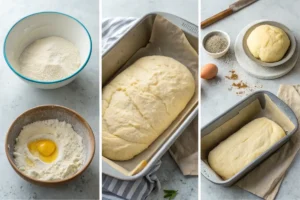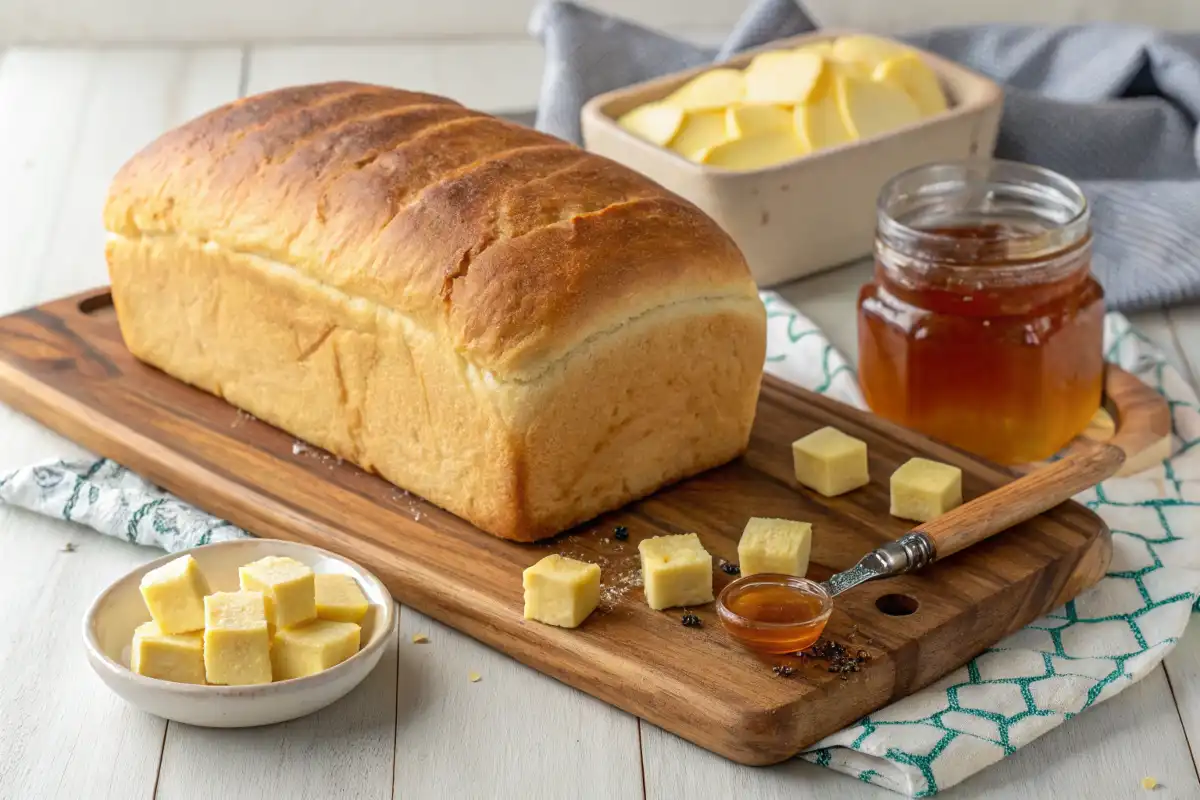Butter bread is more than just a delicious baked good—it’s a blend of rich flavors, soft textures, and an experience that fills your home with the irresistible aroma of freshly baked bread. This guide will take you through every step of how to bake butter bread, from understanding the science behind perfect dough to experimenting with variations to suit your taste. By the end, you’ll have the confidence to create a masterpiece that rivals bakery-quality bread.
In this article, you’ll learn the basics of butter bread baking, the secrets to achieving the right balance of ingredients, and troubleshooting tips for common baking challenges. Let’s dive in and bring the art of bread baking to life!
Introduction to Butter Bread
What is Butter Bread?
Butter bread is a classic, enriched bread known for its soft, fluffy texture and buttery flavor. Unlike plain bread, butter bread incorporates a generous amount of butter into the dough, creating a richer and more indulgent taste. This bread is versatile—it can be enjoyed fresh from the oven, toasted with spreads, or paired with savory dishes.
Why Bake Butter Bread at Home?
Baking butter bread at home offers control over the ingredients and allows you to enjoy a fresh loaf free from preservatives. Homemade bread is healthier and more cost-effective than store-bought options. Plus, there’s a sense of accomplishment in creating a loaf that’s uniquely yours. The process of kneading dough, proofing, and baking can be therapeutic, and the end result is a loaf full of homemade goodness.
Key Ingredients and Tools Overview
To make butter bread, you’ll need bread flour, active dry yeast, milk, sugar, butter, and a pinch of salt. Common tools include a stand mixer (or a sturdy pair of hands for kneading), a mixing bowl, a loaf pan, and an oven. For an enhanced flavor, ingredients like nutmeg or honey can be added.
The Science Behind Perfect Butter Bread
Understanding Yeast and Fermentation
Yeast is the powerhouse of bread baking. When mixed with dough, it feeds on sugars, releasing carbon dioxide gas and alcohol through fermentation. The trapped gas causes the dough to rise, creating that signature soft and airy texture. Proper fermentation is essential for rich flavors and a lighter crumb. Allowing the dough enough time to rise enhances its complexity, making it worth the wait. For a deeper dive into the science behind yeast and fermentation, check out this helpful guide.
The Role of Butter in Bread Baking
Butter does more than add flavor—it’s a game-changer for texture. This fat enriches the dough, producing a softer crumb and moist loaf. Butter also slows gluten formation slightly, which keeps the bread tender and easy to slice. While baking, butter adds a touch of golden perfection to the crust, enhancing both appearance and taste.
How to Achieve the Right Dough Consistency
Getting the dough just right is crucial. The balance between wet and dry ingredients determines elasticity and structure. Too sticky, and the dough won’t hold its shape; too dry, and it becomes crumbly. Kneading helps develop gluten, which traps air for a fluffy loaf. Use the windowpane test—stretch a small piece of dough until it’s thin and translucent without tearing. This ensures your dough is ready to rise and bake to perfection.
Preparing the Ingredients for Butter Bread
Selecting the Right Flour for Butter Bread
Flour is the foundation of butter bread. Opt for bread flour, which has a higher protein content than all-purpose flour. This extra protein builds more gluten, giving the bread its chewy texture and structure. If you’re experimenting, whole wheat or gluten-free flours can be substituted, but the texture may differ.
Measuring and Preparing the Wet Ingredients
Precision is key when measuring wet ingredients like milk and melted butter. Use room-temperature liquids to ensure they mix evenly with dry ingredients. Warm milk activates the yeast faster, kickstarting fermentation. Avoid hot liquids, as they can kill the yeast, derailing the rising process.
Adding Flavor Enhancers like Nutmeg or Pineapple Essence
A dash of nutmeg or a hint of pineapple essence takes butter bread to the next level. These subtle flavors complement the richness of the butter, making the loaf irresistibly aromatic. Other options include honey for sweetness or herbs for a savory twist. Mix these enhancers into the dough at the kneading stage for even distribution.
Step-by-Step Instructions for Baking Butter Bread
Preparing the Yeast Mixture
Start with activating your yeast. Combine warm milk (not hot) with sugar and active dry yeast in a small bowl. Let it rest for 5-10 minutes until it’s frothy. This step ensures the yeast is alive and ready to work its magic in your dough. If you’re unsure about working with yeast, this savory bread pudding recipe explains the process in a similar context.
Mixing and Kneading the Dough
In a large mixing bowl, combine bread flour, salt, and any flavor enhancers, like nutmeg. Gradually add the frothy yeast mixture and softened butter. Mix until the dough comes together, then transfer it to a floured surface. Knead for about 10-12 minutes or until the dough is smooth and elastic. A stand mixer with a dough hook can save time here.
Proofing the Dough for Maximum Rise
Place the dough in a lightly greased bowl and cover it with a damp cloth. Let it rise in a warm place for about 1-2 hours or until it doubles in size. This fermentation process is crucial for achieving fluffy, airy bread.
Shaping the Loaf
Once the dough has risen, punch it down gently to release air bubbles. Shape it into a loaf and place it in a greased loaf pan. Cover it loosely and let it rise again for 30-45 minutes.
Baking Tips for a Perfect Golden Crust
Preheat your oven to 375°F (190°C). Bake the loaf for 30-35 minutes or until the top is golden brown, and the bread sounds hollow when tapped. For an extra glossy finish, brush the loaf with melted butter right after baking.

Variations and Add-Ons for Butter Bread
Sweet Butter Bread Variations
Turn your butter bread into a dessert-like treat by adding sugar, cinnamon, or dried fruits like raisins. These additions make the bread ideal for breakfast or a sweet snack. You can even swirl in a layer of cinnamon sugar before shaping the loaf.
Savory Additions: Herbs, Cheese, and Garlic
For a savory twist, incorporate fresh herbs like rosemary or thyme into the dough. Shredded cheese or minced garlic also works wonders, giving the bread a robust flavor that pairs well with soups or pasta dishes.
Gluten-Free and Vegan Options
Gluten-free butter bread can be made using a blend of gluten-free flours and xanthan gum. To make it vegan, substitute butter with a plant-based alternative and use almond or oat milk.
For more bread-based inspirations, explore articles like Savory Bread Pudding with Chicken. These variations ensure there’s a butter bread recipe for everyone!
Troubleshooting Common Issues in Butter Bread Baking
Why Did My Bread Not Rise?
If your bread didn’t rise, the yeast might be the culprit. Yeast can die if exposed to hot liquids, so always ensure your milk or water is warm, not hot. Another common issue is expired yeast check the date on the package. Finally, ensure the dough is proofed in a warm environment. A cold kitchen can slow the fermentation process significantly.
How to Fix Overproofed Dough
Overproofed dough happens when it rises too long, leading to a flat loaf. If this occurs, punch down the dough to release excess gas, reshape it, and allow it to proof again for a shorter time. Keeping an eye on the dough during the second rise is critical to avoiding this problem.
Dealing with Cracked or Uneven Crusts
A cracked crust often results from rapid temperature changes. To prevent this, ensure your oven is preheated properly before baking. Additionally, placing a tray of water in the oven can create steam, helping the crust form evenly. If uneven shaping is the issue, pay extra attention when molding the dough into a loaf.
These troubleshooting tips will save your baking day and help you master how to bake butter bread without frustration!
Storing and Serving Butter Bread
Best Practices for Storing Butter Bread
To keep your butter bread fresh, store it in a sealed plastic bag or airtight container at room temperature. Avoid refrigeration, as it can dry out the bread quickly. If you need to store it for longer than a few days, slice the loaf and freeze it. You can thaw slices as needed and toast them for a fresh-out-of-the-oven taste.
Serving Suggestions: Pairing Butter Bread with Spreads and Meals
Butter bread is incredibly versatile. Enjoy it with classic spreads like honey, jam, or butter for breakfast. For savory pairings, serve it alongside soups, stews, or even a hearty salad. Toasted butter bread also makes an excellent base for open-faced sandwiches or garlic bread.
With these storage tips and serving ideas, you’ll maximize the enjoyment of your butter bread while keeping it fresh longer. Experiment with pairings to make your homemade loaf the star of every meal!
FAQs About Baking Butter Bread
How Long Does Butter Bread Last?
Butter bread stays fresh for 2-3 days at room temperature when stored properly. If you need to keep it longer, freezing is the best option. Slice the loaf before freezing so you can easily thaw individual pieces as needed. Avoid refrigerating it, as this can dry out the bread and affect its texture.
Can I Use Salted Butter Instead of Unsalted?
Yes, you can use salted butter, but reduce the added salt in the recipe to balance the flavors. Unsalted butter gives you more control over the salt content, making it a preferred choice for many bakers. Regardless of your choice, the buttery richness remains the same.
Is It Possible to Make Butter Bread Without Yeast?
Yes, but the result will differ in texture and flavor. Yeast is key to making butter bread light and fluffy. For a yeast-free version, consider using baking powder or baking soda as a leavening agent. Keep in mind, though, that this version may resemble more of a quick bread than traditional butter bread.
These frequently asked questions should address common concerns while giving you more confidence in how to bake butter bread successfully.
Conclusion
Recap of Key Steps in Baking Butter Bread
Baking butter bread at home combines simple ingredients with rewarding results. From activating the yeast to shaping the loaf and baking it to golden perfection, each step contributes to a loaf that’s both flavorful and versatile.
Encouragement to Experiment and Share Your Results
Don’t hesitate to experiment with flavors and techniques to make the recipe your own. Share your creations with family and friends—they’ll appreciate your efforts! Once you’ve mastered the basics of how to bake butter bread, the possibilities are endless. Happy baking!

